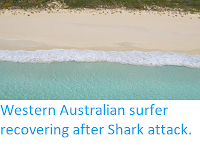A 55-year-old man has died after being attacked while body-boarding off Cable Beach on the north coast of Western Australia on Sunday 22 November 2020. The incident happened at about 8.40 am local time, with the victim being pulled from the water and given first aid immediately, but dying at the scene. The Shark remained in the area for about an hour after the incident, with witnesses identifying it as a Tiger Shark, Galeocerdo cuvier.
Despite their fearsome reputation, attacks by Sharks are relatively rare and most attacks on Humans by Sharks are thought to be mistakes. Tiger Sharks have a diverse diet, including invertebrates, Fish, Birds, Marine Reptiles and Marine Mammals, which we superficially resemble when we enter the water. Marine Mammals are attacked principally for their thick adipose (fat) layers, which are a nutritious high-energy food, but which we lack. Due to this, when Sharks do attack Humans these attacks are often broken off without the victim being consumed. Such attacks frequently result in severe injuries, but are seldom immediately fatal, and victims are likely to survive if they receive immediate medical attention.
Despite this general rarity, Australia appears to be suffering a sharp rise in Shark attacks, with 22 recorded Shark attacks in Australian waters so far this year, eight of them fatal.
Marine biologist Julian Pepperell has suggested that this increase might be linked to a rise in the number of Humpback Whales, Megaptera novaeangliae, passing through Australian waters each year. Humpback Whales are a significant food source for many Sharks; adult Whales are beyond their hunting capacity, but do die of other causes and are enthusiastically scavenged, while larger Sharks such as Great Wights will attack Whale calves. Around 35 000 Humpback Whales currently migrate through Australian Waters each year, according to zoologist Vanessa Pirotta of Macquarie University, a number which is growing by about 11% each year.
The La Niña weather system is the opposite of the El Niño weather
system, in which unusually cold surface temperatures spread across the
equatorial Pacific from the upwelling zone on the South American coast.
This traps warm water from the western Pacific, preventing it from
spreading east and warming the central Pacific. This leads to lower
evaporation over the (cooler) east Pacific, leading to low rainfall on
the west coast of South America, and higher evaporation over the
(warmer) west Pacific, leading to higher rainfall over East and
Southeast Asia and northern Australia.
See also...



Follow Sciency Thoughts on Facebook.
Follow Sciency Thoughts on Twitter.







